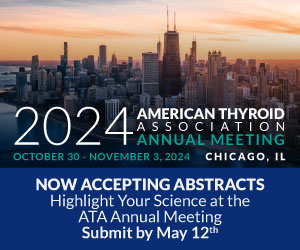Updated September 28, 2002
On July 12, 2001, the Food and Drug Administration’s (FDA) Center for Drug Evaluation and Research (CDER) clarified the status of levothyroxine sodium (thyroxine) products that had not received FDA approval. The CDER statement, entitled “Guidance for Industry, Levothyroxine Sodium products, enforcement of August 14, 2001, Compliance Date and Submission of new Applications,” is at www.fda.gov/cder/guidance/4647fnl.htm.
Any manufacturer that had not submitted a New Drug Application to the FDA by August 14, 2001 had to remove its product from the market immediately. Any manufacturer that filed a new Drug Application by that date, but had not received approval, had to start phasing its product off the market. The phase-out was scheduled to occur over two years (see below) and would end when an application was approved.
What is the current FDA status of specific thyroxine products?
New Drug Applications have been approved for these brands:
Unithroid™ (Watson Pharma)
Levoxyl® (Monarch/Jones Pharma)
Synthroid® (Abbott Laboratories)
Forest Pharmaceuticals awaits FDA approval of the New Drug Application for its product Levothroid®.
What is the current FDA status of generic forms of thyroxine products?
Generic products are subject to the same FDA withdrawal and phase-out regulations as brand-name products that had not had New Drug Applications submitted or approved by August 14, 2001.
The FDA has approved these generic products:
Levo-T® (Mova Pharmaceuticals)
Levothyroxine sodium (Mylan Pharmaceuticals)
Novothyrox® (Genpharm, Inc.)
Qualitest Pharmaceuticals awaits FDA approval of the Abbreviated New Drug Application for its product levothyroxine sodium.
The American Thyroid Association (ATA) does not recommend that patients be given generic thyroxine preparations because every time patients fill a prescription for thyroxine, they may be given a different manufacturer’s product, and the FDA has not ruled that different thyroxine preparations are interchangeable. The ATA cannot predict the impact of removing generic preparations from the market.
What is the ATA’s view of the FDA actions?
The ATA supports the FDA’s mandate to review and approve thyroxine preparations. The ATA, the Endocrine Society, ThCa: Thyroid Cancer Survivors’ Association, the National Graves’ Disease Foundation, and the Lawson Wilkins Pediatric Endocrine Society also support the continued availability of thyroxine preparations during the FDA review (www.thyroid.org/publications/statements/01_06_04_hormone.html).
The ATA believes that FDA guidelines allow it to review New Drug Applications while ensuring the continued availability of thyroxine preparations. The ATA urges the FDA to act promptly on pending New Drug Applications for thyroxine preparations.
How long does FDA take to approve a drug?
The average time between submission of a New Drug Application and FDA approval is 10 to 12 months.
How does the phase-out plan work?
Starting in August, 2001, any manufacturer that had applied for but not yet received FDA approval had to reduce distribution of its product by a set percentage every three months. By August 2002, distribution would fall to 60%. In August 2003, distribution would cease. When the FDA approves a product, all restrictions on its distribution are lifted. Because three thyroxine preparations have already been approved and because the FDA is phasing out the non-approved drug slowly, the ATA expects that supplies of thyroxine products will remain adequate.
If patients are taking a non-approved drug, should they be switched to an approved drug?
There is no immediate need for patients to switch drugs. The FDA timed its phase-out to allow enough time for doctor and patient to reach a decision about switching during the patient’s next regularly scheduled appointment.
What if a patient wishes to switch drugs, or the supply of a particular product runs short?
Many patients can be safely switched from their current thyroxine product to another one, even though the FDA has not ruled that the different products are interchangeable. When patients switch to a new drug, they need a TSH (thyroid-stimulating hormone) test 6 to 12 weeks later. (If patients switch 6 to 12 weeks before their next regularly scheduled appointment, they can have their TSH test done during that appointment.) Depending on the TSH test result, the dose of the new drug may need to be adjusted.
Patients should keep taking the prescribed dose of their current drug and should change their treatment only under their doctor’s supervision.
What about patients who are starting thyroxine therapy for the first time?
These patients should depend on their physician’s experience with the various brands of thyroxine. No matter what drug patients start on, there is some chance that short-term supplies will become limited. This risk may be lower for the approved drugs because their production is not restricted by the FDA phase-out. Because the different brands are not interchangeable, if a brand does become unavailable, patients must be switched to another product and must have follow-up TSH testing.



